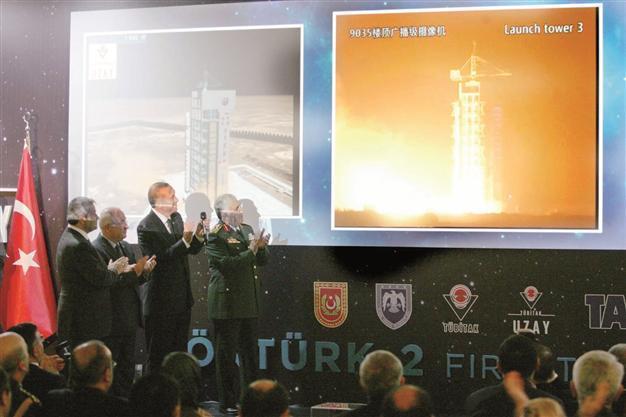Turkey striving to synchronize aerospace ambitions by 2023
Burak BEKDİL

A Turkish earth-observation satellite named Göktürk-2 was launched from Jiuquan, China, in December 2012. The satellite was designed and built by TÜBİTAK’s space technologies research unit. DHA photo
Officials at Turkey’s emerging “space command structure,” now a branch of the country’s Air Force, is striving to achieve an ambitious, long-term objective that it believes will make Turkey a “space power” by 2023, the centenary of the Turkish Republic.“When combined successfully, these three ventures will make Turkey a space power,” said one senior military officer familiar with space and related programs. “We are aware that this is an ambitious goal, but certainly not unattainable, given our fast-growing experience and technological infrastructure.”
Turkish officials and aerospace experts are working overtime to achieve that broadly defined goal, aiming, eventually, to synchronize work in three fields: building a national long-range air defense and anti-missile architecture, developing long-range missiles and constructing the country’s first satellite launching pad.
Turkey is expected to decide later this year on how to proceed with its plans to build a “national” long-range air defense and anti-missile system, a program dubbed T-LORAMIDS.
T-LORAMIDS consists of radar, launcher and intercept missiles. It has been designed to counter both enemy aircraft and missiles. Turkey has no long-range air defense systems. The bidders are a U.S. partnership of Raytheon and Lockheed Martin, offering the Patriot air defense system; Russia’s Rosoboronexport, marketing the S-300; the China Precision Machinery Export-Import Corp., offering its HQ-9; and the Italian-French consortium Eurosam, maker of the SAMP/T Aster 30.
But defense procurement officials have indicated that Turkey is strongly leaning toward adopting a Chinese long-range anti-missile and air defense system even though it may be impossible to integrate the system with its existing NATO architecture.
They say the Chinese proposal was technologically satisfactory, allowed technology transfer and was much cheaper than rival proposals. The decision to select the Chinese contender is awaiting final approval from Defense Minister İsmet Yilmaz and Prime Minister Recep Tayyip Erdoğan.
Meanwhile, Turkey is also working on another missile/space-related program that may equally annoy its NATO partners.
In 2011, Turkey announced plans to develop a missile with a maximum range of 2,500 kilometers, not revealing whether it would be ballistic or cruise. Although little information about the program has been released, a Turkish Cabinet minister in January confirmed that Turkey possessed capabilities to produce a missile with a range of 800 kilometers.
TÜBİTAK-Sage, an affiliate of the state scientific institute TÜBİTAK, has been awarded the development contract and has indicated that it intends to test a prototype within the next two years. However, independent analysts say this development plan appears to be overly ambitious.
The military official did not comment on the program.
The country made a breakthrough on the third priority leg of the planned space architecture in July when Turkey approved the construction of its first satellite launching center to cater for the country’s mushrooming satellite programs.
Turkey’s defense procurement agency, the Undersecretariat for Defense Industries (SSM), signed a contract with the country’s national missile manufacturer, Roketsan, to build the Turkish Satellite Launching System (UFS) for pre-conceptual design work. Under the contract, Roketsan will design the UFS to be capable of launching, initially, satellites into low-earth orbit (500 to 700 kilometers) through a launching center the company will build and the Turkish Air Force will operate.
But some of Turkey’s NATO allies fear that Ankara could in the future use its satellite launcher also as a launching pad for its intended 2,500-kilometer-range missiles, according to Western diplomats. At the moment, the Turkish military’s space-based assets are geared more toward ISR missions, but Turkey has so far been dependent on other nations to launch its satellites.
Observation satellite passes tests
A Turkish earth-observation satellite named Göktürk-2 was launched from Jiuquan, China, in December 2012. The satellite was designed and built by TÜBİTAK’s space technologies research unit, TÜBİTAK-UZAY, in cooperation with Turkish Aerospace Industries (TAI). Göktürk-2 is Turkey’s second national satellite following RASAT, which also was developed by TÜBİTAK-UZAY and launched from Russia on Aug. 17, 2011.
In an August report, TÜBİTAK said the Göktürk-2 successfully passed the Defense Ministry’s acceptance tests on June 28. The report said an orbit test concluding report was not being prepared.
In early 2013, Turkey’s Defense Industry Executive Committee approved contract negotiations with TAI for the domestic development of a synthetic aperture radar spacecraft dubbed Göktürk-3. TÜBİTAK’s August report said TÜBİTAK’s proposals for Göktürk-3’s subsystems were now being assessed by TAI.
Turkey also plans to launch the Göktürk-1 in the next few years. Göktürk-1, under construction under a deal with Telespazio and Thales Alenia Space, is a larger and more powerful optical imaging spacecraft capable of sub-meter resolution that is similar to the French Pleiades earth observation satellites built by EADS-Astrium.
According to a government road map for military and civilian satellites, Turkey plans to send into orbit a total of 16 satellites until 2020. A space industry expert based in Turkey said the next five years’ satellite contracts could amount to $2 billion.
















